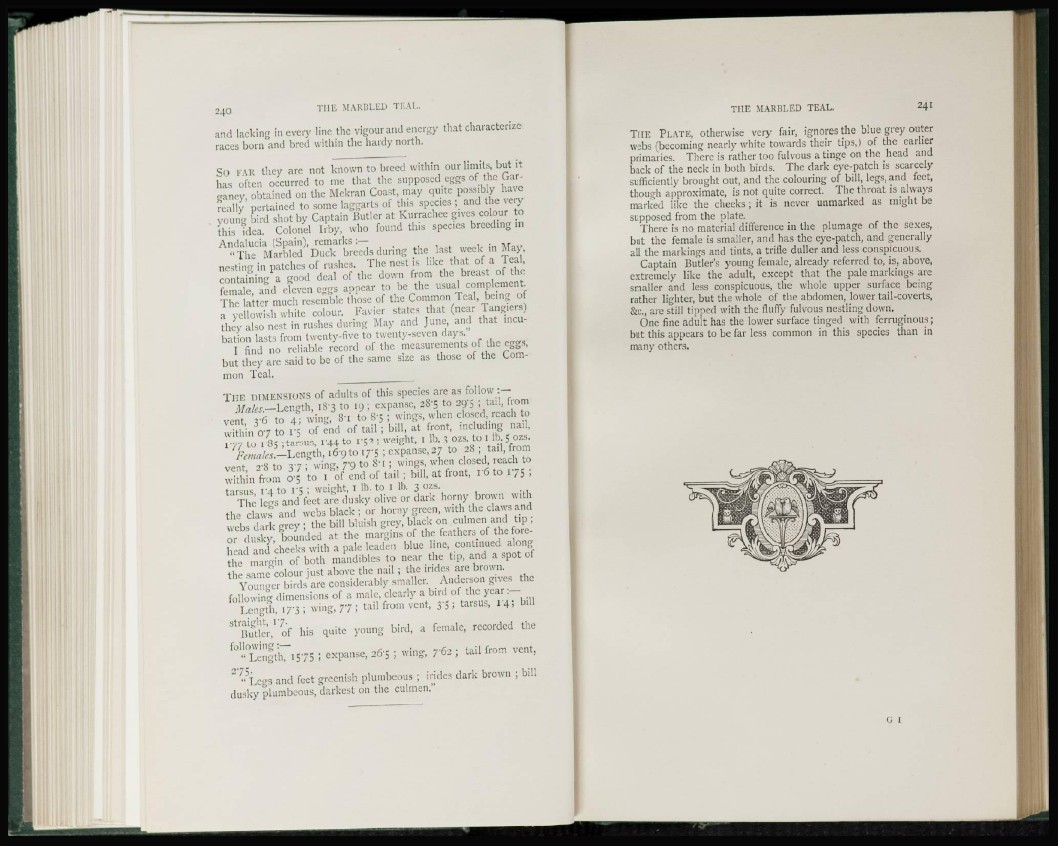
and lacking in every line the vigour and energy that characterize
races born and bred within the hardy north.
So f a r they are not known to breed within our limits, but it
has often occurred to me that the supposed eggs of the Gargancy,
obtained on the Mekran Coast, may quite possibly have
really pertained to some laggarts of this species ; and the very
young bird shot by Captain Butler at Kurrachee gives colour to
this idea. Colonel Irby, who found this species breeding in
Andalucía (Spain), remarks :—
" The Marbled Duck breeds during the last week in May,
nesting in patches of rushes. The nest is like that of a Teal,
containing a good deal of the down from the breast of the
female, and eleven eggs appear to be the usual complement.
The latter much resemble those of the Common Teal, being of
a yellowish white colour. Favier states that (near Tangiers)
they also nest in rushes during May and June, and that incubation
lasts from twenty-five to twenty-seven days."
I find no reliable record of the measurements of the eggs,
but they arc said to be of the same size as those of the Common
Teal.
THE DIMENSIONS of adults of this species are as follow :—
Males.—Length, I S3 to 19 ; expanse, 2S'5 to 29-5 ; tail, from
vent, 3'6 to 4; wing, 8'i to 8*5 ; wings, when closed, reach to
within 0*7 to i'5 of end of tail ; bill, at front, including nail,
177 to 1S5 ; tarsus, 144 to 152 ; weight, I lb. 3 ozs. to I lb. 5 ozs.
Females.—Length, 169to 17-5 ; expanse,27 to 28; tail, from
vent, 2"S to 37 ; wing, 7"9 to 8 r ; wings, when closed, reach to
within from 0'5 to I of end of tail ; bill, at front, i'6 to 175 ;
tarsus, 14 to 1*5 ; weight, 1 lb. to I lb. 3 ozs.
The legs and feet arc dusky olive or dark horny brown with
the claws and webs black ; or horny green, with the claws and
webs dark grey ; the bill bluish grey, black on culmen and tip ;
or dusk)', bounded at the margins of the feathers of the forehead
and cheeks with a pale leaden blue line, continued along
the margin of both mandibles to near the tip, and a spot of
the same colour just above the nail ; the irides are brown.
Younger birds are considerably smaller. Anderson gives the
following dimensions of a male, clearly a bird of the year:—
Length, 17-3 ; wing, 7 7 ; tail from vent, 35 ; tarsus, 1 4 ; bill
straight, 17.
Butler, of his quite young bird, a female, recorded the
following :—
"Length, 1575 ; expanse, 26'5 ; wing, 762 ; tail from vent,
275.
" Legs and feet greenish plumbeous ; irides dark brown ; bill
dusky plumbeous, darkest on the culmen."
THE PLATE, otherwise very fair, ignores the blue grey outer
webs (becoming nearly white towards their tips,) of the earlier
primaries. There is rather too fulvous a tinge on the head and
back of the neck in both birds. The dark eye-patch is scarcely
sufficiently brought out, and the colouring of bill, legs, and feet,
though approximate, is not quite correct. The throat is always
marked like the cheeks ; it is never unmarked as might be
supposed from the plate.
There is no material difference in the plumage of the sexes,
but the female is smaller, and has the eye-patch, and generally
all the markings and tints, a trifle duller and less conspicuous.
Captain Butler's young female, already referred to, is, above,
extremely like the adult, except that the pale markings are
smaller and less conspicuous, the whole upper surface being
rather lighter, but the whole of the abdomen, lower tail-coverts,
&c, are still tipped with the fluffy fulvous nestling down.
One fine adult has the lower surface tinged with ferruginous;
but this appears to be far less common in this species than in
many others.